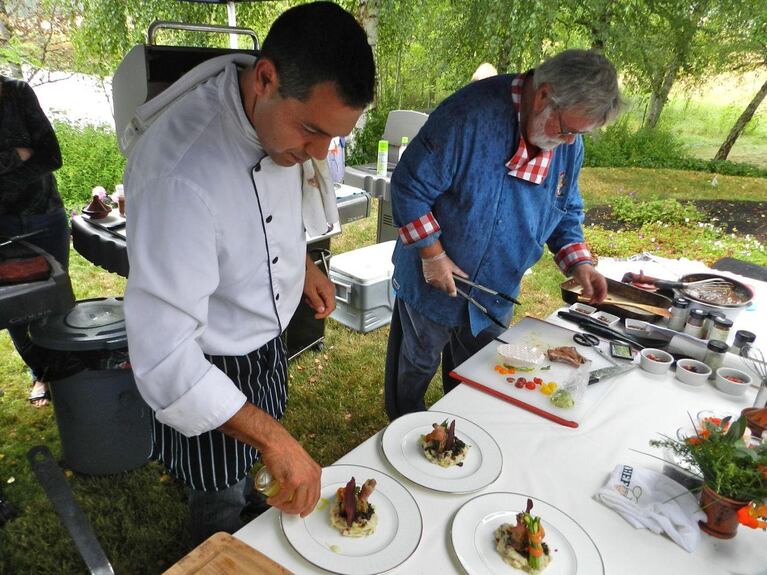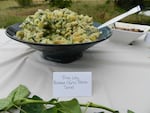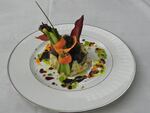
Chefs Hamid Serdani, left, and Jason Biga compete in an invasive species cookoff in Philomath, Ore.
Cassandra Profita
(Editor’s note: EarthFix Field Notes are reporters’ personal impressions and experiences from their coverage of the Pacific Northwest. In this entry, Reporter Cassandra Profita recounts her experience judging the culinary fare at an invasive species cook off.)
PHILOMATH, Ore. -- I was just about to take my very first bite of feral swine when something stopped me.
It wasn't the fact that this pig was an invasive species; that it was killed by wildlife officials in Eastern Oregon because it was a nuisance, a disease carrier and an environmental threat.
It was the photographers.
Everywhere I looked as I raised that forkful of wild pork, people were pointing cameras at me. They had come from The Wall Street Journal, the Los Angeles Times, the Corvallis Times-Gazette and all over the Northwest.
The sight of me chewing and swallowing wasn't the big draw, but that was an essential part of it. Yesterday, I was one of three judges in an invasive species cook off at Chintimini Farms. It was organized by the Institute for Applied Ecology and the Oregon Invasive Species Council. And yes, eventually I got over my camera shyness and took that first bite, which was followed by many others.
The theme of the event, "eradication by mastication," suggested to attendees that maybe together we can eat our way through the problem of invasive species disrupting the natural ecosystem.
The contest was set up a bit like the Food Network show "Chopped." Three noteworthy chefs were given an hour to prepare a dish using three invasive species: feral swine, dandelion greens and Himalayan blackberries. The judges scored the food on its taste, creativity and presentation.
Scores were tallied and the chefs were ranked in first, second and third place. Chef Jason Biga of Aqua Seafood Restaurant in Corvallis took first place with his interpretation of Korean barbecue: Marinated and grilled feral pig medallions with a quick kimchi made with dandelion greens as well as invasive purslane and chicory. He topped the dish with invasive borage flowers and blackberries rolled in crystallized ginger.
Invasive species never tasted so good!
The competing dishes were delicious, too. Personal chef Hamid Serdani of Corvallis used French ham and African spices to flavor the pork chop, which he perched vertically on a bed of garlic mashed potatoes and sauteed dandelion greens. He topped the dish with a blackberry balsamic curry sauce.
Rick Browne of Vancouver, Wash., who hosts the PBS show Barbecue America, served a grilled pork chop with a gingery mango-blackberry salsa and alongside potatoes cooked in rendered duck fat and a dandelion green salad with bacon, egg and a balsamic vinaigrette. He also incorporated honey from invasive Africanized honeybees.
Everyone attending got to try a lot of other invasive species dishes, too: Smoked salmon puffs made with invasive sheep sorrel, piquillo peppers stuffed with invasive crayfish, bullfrog leg potato salad, dandelion spanakopita, and wild boar bratwurst.
The food was fantastic, and by eating it we were all helping to replace invasive plants and animals with native species that belong in the Northwest landscape. Hooray!
But here’s the problem: It's going to take a lot more than a tasty meal to wipe out invasive species.
"We don't expect to eradicate these species by eating them," said Tom Kaye, executive director of the Institute for Applied Ecology. "The idea here is to raise awareness, to literally bring people to the table with food."
Even a highly edible species like Himalayan blackberry won't be eliminated at our dinner tables, he said, no matter how many blackberry crumbles we make.
"It's like a super-species," said Kaye. "It literally flies across the landscape because birds eat the fruit and spread the seed. It can produce seeds without insect pollination. It can grow new roots from the tip of a growing plant – just by leaning over and touching the ground next to it."
Blackberry plants are so competitive – so effective at boxing out habitat for native plants – that plucking some berries and making a pie is not going to stop it. But Kaye says if people learn which blackberry plants are invasive through so-called “invasivore” foodie events, he’s hoping they’ll be more likely to take additional actions to eliminate the plants.
"Mowing works great, if you can mow many times a year," Kaye said. "You can dig out the root system and use chemical sprays where appropriate. Burning works pretty well. Or you can combine those techniques."
Kaye also wants to make sure people don't get too accustomed to eating invasive species.
"If an invasive species becomes a popular item, there's pressure to keep it on the landscape – not eradicate it," Kaye said. "We really don't want these things on the landscape at all."
So, advocates say, enjoy them if you can – while you can – but be ready to say goodbye.








